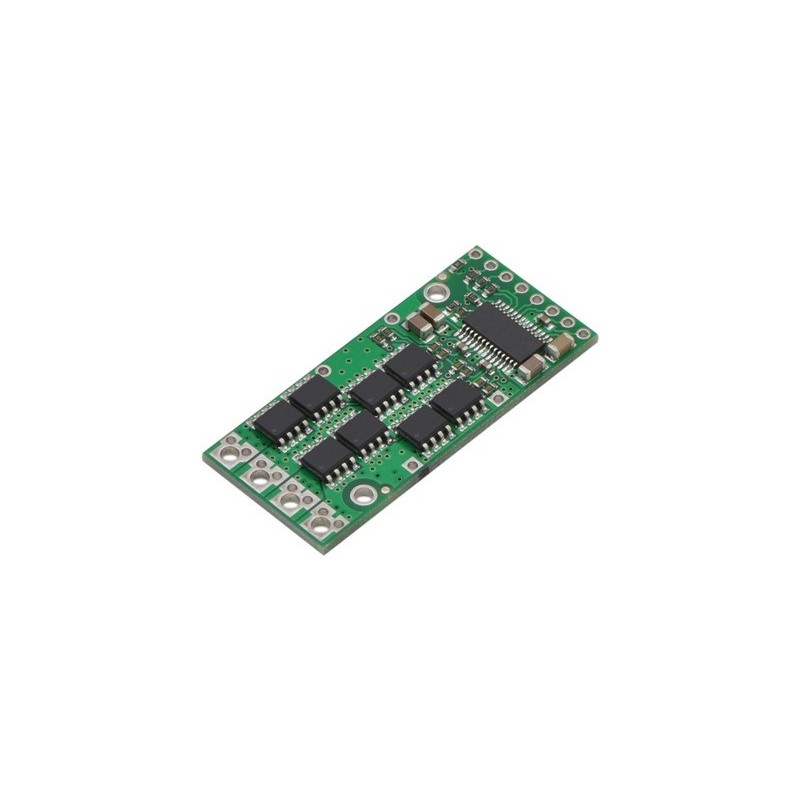



186,71 zł Netto
Wysokoprądowy sterownik silnika D 36v15 Pololu umożliwia sterowanie silnikami DC w systemach do 50 V przy zachowaniu niewielkich wymiarów i prostego interfejsu sterującego. Moduł znajduje zastosowanie w projektach wymagających prądu do 15 A bez radiatora oraz możliwości zwiększenia wydajności prądowej poprzez dodatkowe chłodzenie. Pololu 760
Pololu High-Power Motor Driver 36v15 przeznaczony do dwukierunkowego sterowania jednym szczotkowym silnikiem prądu stałego w aplikacjach wysokonapięciowych. Moduł wykorzystuje dyskretny mostek H oparty na tranzystorach MOSFET typu N i obsługuje szeroki zakres napięcia zasilania od 5,5 V do 50 V, co umożliwia zastosowanie w systemach 24 V oraz 36 V.
Kompaktowa płytka o wymiarach 1,8 × 0,8 cala umożliwia dostarczanie do 15 A prądu ciągłego bez radiatora, a przy dodatkowym chłodzeniu do około 20 A. Prosty interfejs sterowania wymaga jedynie dwóch linii sygnałowych (PWM i DIR), co ułatwia integrację z mikrokontrolerami i systemami nadrzędnymi. Sterownik obsługuje tryby sign-magnitude oraz locked-antiphase, pozwalając na elastyczny dobór metody regulacji prędkości i kierunku obrotów.
Układ zapewnia detekcję zwarć, spadków napięcia oraz przegrzania, sygnalizowanych na wyjściach FF1 i FF2. Brak sprzętowych zabezpieczeń nadprądowych i temperaturowych wymaga odpowiedniego doboru silnika, zapewnienia chłodzenia oraz w aplikacjach granicznych stosowania zewnętrznego monitorowania prądu. Rozwiązanie sprawdza się w robotach mobilnych, napędach o dużej mocy i projektach prototypowych wymagających wysokiego napięcia zasilania.
Cechy
Producent BTC Korporacja sp. z o. o. Lwowska 5 05-120 Legionowo Polska sprzedaz@kamami.pl 22 767 36 20
Osoba odpowiedzialna BTC Korporacja sp. z o. o. Lwowska 5 05-120 Legionowo Polska sprzedaz@kamami.pl 22 767 36 20
Moduł sterownika dwóch silników szczotkowych DC o wydajności prądowej do 5 A na kanał. Może współpracować z pakietami LiPo 2S i 3S
Pololu Simple High-Power Motor Controller 18v15
Brak towaru
Kompaktowa moduł regulatora ESC przeznaczona do silników BLDC, idealna dla dronów i mobilnych konstrukcji. Wyposażona w układ STSPIN32F0A oraz tranzystory o bardzo niskiej rezystancji RDS(on), zapewnia wydajną pracę i prądy do 20 A. Obsługuje pakiety LiPo 2S–6S i oferuje precyzyjne sterowanie bezczujnikowe dzięki detekcji BEMF. STMicroelectronics STEVAL-ESC002V1
Brak towaru
Moduł zawiera dwa sterowniki silników L293D oraz rejestr przesuwny 74HC595. Rejestr przesuwny rozszerza 3 linie Arduino do 8 linii, co pozwala na sterowanie kierunkiem pracy silników. Wyjście L293D jest bezpośrednio sterowane wyjściami PWM Arduino
Moduł ze sterownikiem silnika DC DRV8876. Może współpracować z silnikami zasilanymi napięciem od 4,5 do 37 V i poborze prądu do 1,3 A. Pololu 4036
Jednokanałowy sterownik silników DC z interfejsem UART TTL. Jest zasilany napięciem od 1,8 V do 22 V i może dostarczyć prąd o natężeniu do 1,8 A. Płytka ze złączami do montażu. Pololu 5077
RoboClaw 2x7A Motor Controller (V5B) to dwukanałowy sterownik silników prądu stałego (DC), napięcie pracy: 6-34 V, maksymalny prąd ciągły: 7,5 A, możliwość łatwej realizacji pętli sprzężenia zwrotnego z regulatorem PID, systemy bezpieczeństwa. Pololu 3284
X-NUCLEO-IHM11M1 to niskonapięciowy sterownik trójfazowych silników bezszczotkowych DC (BLDC) dla płytek serii STM32 Nucleo. Shield oparty jest na układzie STSPIN230. Idealnie nadaje się do użycia w urządzeniach zasilanych z baterii (roboty, zabawki). Shield wyposażony jest w złącze zgodne ze standardem Arduino UNO R3
Brak towaru
Sterownik silników DC, który pozwala na kontrolowanie ruchu dwóch napędów za pomocą interfejsu I2C. Płytka z przylutowanymi złączami. Pololu 5042
Brak towaru
Moduł sterownika silnika bezszczotkowego (regulator ESC) o wydajności prądowej do 20 A
Moduł sterownika RC typu ESC z odbiornikiem FlySky. Pozwala na sterowanie dwoma silnikami w dwóch kierunkach oraz jednym silnikiem w jednym kierunku. Dasmigro 2.4G 7CH
Dwukanałowy sterownik silników elektrycznych (mostek H) Arduino Motor Shield Rev3 z układem L298 do sterowania dwóch silników DC lub jednego silnka krokowego z możliwością użycia hamulca elektronicznego. Arduino A000079
Brak towaru
RPi Motor Driver Board to sterownik przeznaczony dla dwóch silników DC lub jednego silnika krokowego. Sterownik jest przystosowany do dołączenia do komputerów serii Raspberry Pi A+, B+, 2 B i 3 B
Pololu G2 24v19 High Power to miniaturowy sterownik silnika DC. Zasilanie sterownika: 6,5...40V. Wydajność prądowa modułu: 19A. Moduł posiada zabezpieczenie przed napięciem wstecznym i przepięciami. Pololu 1367
Brak towaru
Moduł dwukanałowego sterownika silników DC oparty o popularny mostek H L298, zasilany napięciem 6-35 V, maksymalny pobór prądu na jeden kanał 2A, radiator do chłodzenia układu. SparkFun ROB-09670
Brak towaru
DRV8825 Stepper Motor Driver Carrier to sterownik silnika krokowego z układem DRV8825, pozwala na zasilanie silnika bipolarnego prądem do 1,5A na fazę, bez użycia radiatora. Układ może być zasilany napięciem do 45V, w zestawie znajduje się radiator. Pololu 2133

Wysokoprądowy sterownik silnika D 36v15 Pololu umożliwia sterowanie silnikami DC w systemach do 50 V przy zachowaniu niewielkich wymiarów i prostego interfejsu sterującego. Moduł znajduje zastosowanie w projektach wymagających prądu do 15 A bez radiatora oraz możliwości zwiększenia wydajności prądowej poprzez dodatkowe chłodzenie. Pololu 760
